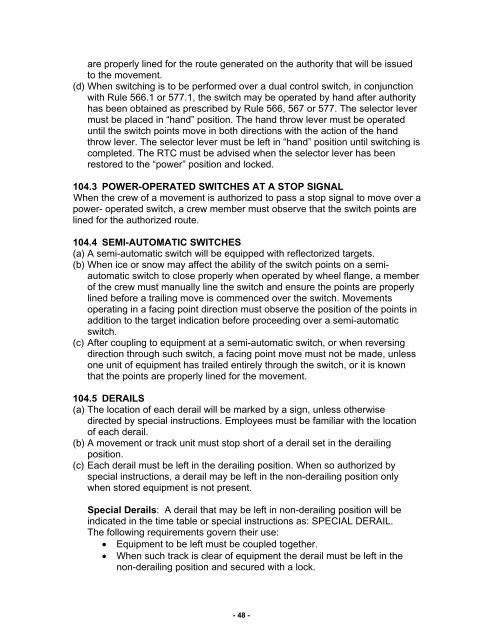Canadian Rail Operating Rules (CROR) TC O-0-93 - PDF
Canadian Rail Operating Rules (CROR) TC O-0-93 - PDF
Canadian Rail Operating Rules (CROR) TC O-0-93 - PDF
You also want an ePaper? Increase the reach of your titles
YUMPU automatically turns print PDFs into web optimized ePapers that Google loves.
are properly lined for the route generated on the authority that will be issued<br />
to the movement.<br />
(d) When switching is to be performed over a dual control switch, in conjunction<br />
with Rule 566.1 or 577.1, the switch may be operated by hand after authority<br />
has been obtained as prescribed by Rule 566, 567 or 577. The selector lever<br />
must be placed in “hand” position. The hand throw lever must be operated<br />
until the switch points move in both directions with the action of the hand<br />
throw lever. The selector lever must be left in “hand” position until switching is<br />
completed. The R<strong>TC</strong> must be advised when the selector lever has been<br />
restored to the “power” position and locked.<br />
104.3 POWER-OPERATED SWI<strong>TC</strong>HES AT A STOP SIGNAL<br />
When the crew of a movement is authorized to pass a stop signal to move over a<br />
power- operated switch, a crew member must observe that the switch points are<br />
lined for the authorized route.<br />
104.4 SEMI-AUTOMATIC SWI<strong>TC</strong>HES<br />
(a) A semi-automatic switch will be equipped with reflectorized targets.<br />
(b) When ice or snow may affect the ability of the switch points on a semiautomatic<br />
switch to close properly when operated by wheel flange, a member<br />
of the crew must manually line the switch and ensure the points are properly<br />
lined before a trailing move is commenced over the switch. Movements<br />
operating in a facing point direction must observe the position of the points in<br />
addition to the target indication before proceeding over a semi-automatic<br />
switch.<br />
(c) After coupling to equipment at a semi-automatic switch, or when reversing<br />
direction through such switch, a facing point move must not be made, unless<br />
one unit of equipment has trailed entirely through the switch, or it is known<br />
that the points are properly lined for the movement.<br />
104.5 DERAILS<br />
(a) The location of each derail will be marked by a sign, unless otherwise<br />
directed by special instructions. Employees must be familiar with the location<br />
of each derail.<br />
(b) A movement or track unit must stop short of a derail set in the derailing<br />
position.<br />
(c) Each derail must be left in the derailing position. When so authorized by<br />
special instructions, a derail may be left in the non-derailing position only<br />
when stored equipment is not present.<br />
Special Derails: A derail that may be left in non-derailing position will be<br />
indicated in the time table or special instructions as: SPECIAL DERAIL.<br />
The following requirements govern their use:<br />
• Equipment to be left must be coupled together.<br />
• When such track is clear of equipment the derail must be left in the<br />
non-derailing position and secured with a lock.<br />
-48-

















